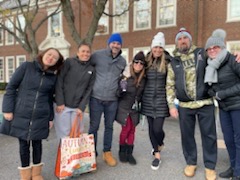Wondering How to Vote? LWVS Offers Views on Proposed Amendments to the SBNC Resolution
- Details
- Written by: Joanne Wallenstein
- Hits: 1931
 The election for the School Board Nominating Committee will be held on Tuesday January 11, 2021 from 7 – 10 am and 2 – 9 pm at Scarsdale Middle School. Along with voting for members of the SBNC, (see their bios here) voters will be asked to vote “Yes” or “No” on eight amendments to the non-partisan resolution that governs the nominating process. The last proposed amendment would permit Scarsdale residents who are not U.S. citizens to serve on the School Board Nominating Committee and to vote in the election for the first time. Another amendment would require the committee to ask each candidate “individualized and differentiated questions,” which is a departure from the current procedure of asking each candidate to make an oral presentation.
The election for the School Board Nominating Committee will be held on Tuesday January 11, 2021 from 7 – 10 am and 2 – 9 pm at Scarsdale Middle School. Along with voting for members of the SBNC, (see their bios here) voters will be asked to vote “Yes” or “No” on eight amendments to the non-partisan resolution that governs the nominating process. The last proposed amendment would permit Scarsdale residents who are not U.S. citizens to serve on the School Board Nominating Committee and to vote in the election for the first time. Another amendment would require the committee to ask each candidate “individualized and differentiated questions,” which is a departure from the current procedure of asking each candidate to make an oral presentation.
The statement from the League notes that the tight timetable for the proposed changes from the SBNC Administrative Committee did not allow for “ample voter education efforts and solicitation of community-wide feedback prior to the January election.” They ask that in the future the SBNC Resolution be amended to “provide sufficient notice to the public of any proposed SBNC Resolution amendments as well as to establish a more meaningful public comment process in which to solicit, receive, and respond to comments from the entire community.”
The League of Women Voters of Scarsdale reviewed the proposed amendments and offers their position on each below. (Note that there is no number 5.)
Amendment 1 (Article III, Section A.4(d)) would require Nominating Committee members to recuse themselves from all SBNC proceedings if a close relative, as defined in the amendment, is a potential school board candidate being considered by the SBNC.
The League has consistently observed that conflicts of interest, whether perceived or actual, have a detrimental effect on any democratic process. Efforts to eliminate that perception or reality are in the greater interest of a well-functioning and respected democratic process. Therefore, the League supports this proposed amendment.
Amendment 2 (Article III, Section B.1(a,b)) would establish and set forth the parameters of a formal orientation meeting for new Nominating Committee members.
The League has strongly supported and encouraged the retention and codification of institutional knowledge as a key component in a highly-functioning democratic institution. Therefore, the League supports this proposed amendment.
Amendment 3 (Article III, Section B.3(a,b)) would establish a “Resolution Clarification Committee” to resolve issues of interpretation of or compliance with the SBNC Resolution.
The League neither supports nor opposes this proposed amendment.
Amendment 4 (Article III, Section C.2(a,b,c)) would change the procedures for interviewing candidates by requiring candidates to make an oral presentation to the Nominating Committee and to answer interview questions posed by Nominating Committee members. The proposed amendment requires the SBNC to ask 1) the same initial questions and 2) “individualized and differentiated questions” of all candidates.
According to the Vice Chair, input from current and former Nominating Committee members as well as previous candidates supported a required interview with the SBNC rather than an optional interview. The Vice Chair noted that a common theme of the feedback reflected the general desire for greater flexibility and interaction with candidates to create a truer “interview” feel in the candidate search process. The proposed amendment offers a general framework in which both initial as well as individualized and differentiated questions must be asked, but it does not enumerate the procedures for formulating and approving interview questions or the manner in which questions will be asked during the interview process.
While the League commends the decision to require an interview process allowing the Nominating Committee to better evaluate potential candidates instead of the current optional language in the SBNC Resolution, the League has reservations about the challenges in implementing a procedure for formulating and asking individualized and differentiated questions. Additionally, the League has concerns regarding the potential for bias which may result from such individualized and differentiated questioning.
Due to the above-mentioned concerns, the League neither supports nor opposes this proposed amendment.
Amendment 6 (Article III, Section C.2(d)) would require the SBNC to contact both references provided by, and at least one reference not provided by, each potential school board candidate being considered by the SBNC.
The League supports the proposed amendment.
Amendment 7 (Article III, Section C.2(e, f)) would require the SBNC to discuss objective criteria for evaluating candidates as well as the qualifications and experience of candidates.
We commend the SBNC for providing guidance in evaluating candidates to better ensure that all candidates are treated fairly. The League supports the proposed amendment.
Amendment 8 (Article III, Section C.2(g)) would specify the information SBNC members must keep confidential.
The League supports the confidentiality requirement of the SBNC’s nonpartisan nominating process and therefore supports this proposed amendment.
Amendment 9 (Article V, Article I) allows noncitizens residing in Scarsdale to serve on the SBNC and vote in SBNC elections.
The League recognizes the contributions of noncitizen residents who participate in all aspects of community life in Scarsdale and whose children are eligible to attend Scarsdale Public Schools. We approve the expansion of eligibility to vote in the SBNC election and serve on the SBNC as a means to increase opportunities for noncitizen residents to be engaged in local civic activities and to ensure that the composition of the SBNC more closely reflects the community it serves. Diversity, equity, and inclusion are central to creating a more perfect democracy. Accordingly, the League strongly supports this proposed amendment.
However, the League recognizes the potential for this amendment to cause confusion among residents, since, under New York state law, noncitizens remain ineligible to vote in the actual school budget/school board election and are ineligible to run as candidates for or serve on the Scarsdale Board of Education. We urge the SBNC to undertake significant efforts to educate the public regarding this disparity to avoid uncertainty or disappointment at the polls.
Conclusion
The League appreciates the Committee’s efforts to improve the SBNC election system. The League believes that a greater effort to educate the public and the provision of additional time to review and comment upon proposed amendments to the SBNC Resolution would increase community engagement and further enhance the nonpartisan School Election System.
How Much Public Comment is Enough? Board Debates Time Limits on Public Participation
- Details
- Written by: Joanne Wallenstein
- Hits: 3859
 At the height of the pandemic, with some school buildings closed, social distancing in force and remote learning replacing in class attendance, parents had a lot to say to the Board of Education about school policies. As a result some meetings extended late into the night, and the Board struggled to do their business and hear comments from the public.
At the height of the pandemic, with some school buildings closed, social distancing in force and remote learning replacing in class attendance, parents had a lot to say to the Board of Education about school policies. As a result some meetings extended late into the night, and the Board struggled to do their business and hear comments from the public.
With that experience in mind, the Board re-examined their policies on public comments and reviewed proposed changes at the December 6, 2021 meeting. They discussed the time limit for individual remarks, the overall time limit for the first public comment period and for the second as well. They also reviewed when to respond to the comments, i.e. after the first public comment session, after the second, or after both.
Currently individual remarks are capped at three minutes, with a one and a half hour limit on the first public session and no limit on the timing of the second session.
The Board deliberated at length about this policy, in an attempt to weigh their desire to listen to the public and conduct necessary board business. As Jim Dugan said, “We want to hear from the community and encourage people to express their opinions. It is a meeting of the Board in public, not with the public. There is important business we are attending to. We have to weigh encouraging public comment with the obligation we have to conduct our business in public. Having no time limit could become unwieldy. Having a time limit forces people to make their best points in the time that they have to make them. I support the limit of the first time period to 1 ½ hours and no time limit for the second.”
Ron Schulhof referenced a meeting last year when twenty people who attended the meeting went home without having the opportunity to speak. He said, ““There should be no limit on any of it. (The time limit on individuals) should not be 3 minutes, We don’t usually have this issue unless people need to speak. I don’t feel there should be time limits on the first and second public periods. If people need to speak, we need to hear from them.” He later said, “People often speak on behalf of community groups and then they need to bring multiple people to read their statements,” and “we talk about community engagement and this is a signal to the community that we want to hear from them.”
Amber Yusuf said, “Hearing from our community is important, via email and public comment. We strive to reply to every email so that the writer knows they have been heard. We should do the same with people who attend the meeting. We also need to conduct board meetings. At the height of the pandemic at one meeting we had 34 speakers share their thoughts. I support a 4 minute time limit for the speakers. Without limits on speakers we may run out of time to conduct board business. I don’t not support imposing a time limit on the first or second public comment sessions.”
Jessica Resnick Ault said, “This year we are focusing on community engagement and DEI – some of these comments are difficult to deliver in just 3 minutes.” She later said, “There are subjects that would engender enough conversation that it would exceed 1 ½ hours. I think it is critical not to limit the first public comment period so that we can hear from them before we deliberate. We can have a listening session if we need one to engage the community. I think we owe it to them to listen to those concerns. Comments should naturally moderate themselves. I think it’s worth the tradeoff not to have a time limit.
Karen Ceske said, “I support limit to individual comments. At 3 minutes they will be asked to limit their comments with the expectation that they will not speak for more than 4 minutes.” She commented, “When speaking before the Village Board about our marijuana letter, I had to edit a small portion of our letter. I support limiting first public comment session to 1 ½ hours and I do not believe the second public comment session should be limited.”
At the conclusion of the discussion the Board came to consensus on a 4 minute time limit for individual comments with a warning at 3 minutes, a 90 minute limit on the first public comments session and no limit on the second public comments session. They agreed to have a second reading of this policy at their meeting on January 10, 2022.
Furthermore, they agreed to revise the preamble to public comments to reflect this policy.
About the timing of the response to public comments, the Board agreed to allow for responses after both the first and second public comments sessions.
Edgewood PTA Delivers 180 Thanksgiving Pies
- Details
- Written by: Joanne Wallenstein
- Hits: 1944
 The Edgewood Elementary School Fifth Grade Committee sweetened many Thanksgiving tables this year by delivering pies from Baked by Susan in Croton-on-Hudson directly to homes across town. 180 pies were sold and delivered with proceeds to benefit the Edgewood PTA and Fifth Grade Committee.
The Edgewood Elementary School Fifth Grade Committee sweetened many Thanksgiving tables this year by delivering pies from Baked by Susan in Croton-on-Hudson directly to homes across town. 180 pies were sold and delivered with proceeds to benefit the Edgewood PTA and Fifth Grade Committee.
The most popular offering was apple pie followed by a tie for pumpkin pie and pumpkin bread. We had the apple cranberry and it was delicious.
The committee raised $2,000 which will be used to host special events for the fifth graders in their final year at Edgewood Elementary School.


District Releases Results of Survey on Substance Usage Among Scarsdale High School Students
- Details
- Written by: Joanne Wallenstein
- Hits: 3336
 How has the pandemic impacted substance abuse among Scarsdale teens? A new survey released by Scarsdale High School shows that usage habits are remarkably unchanged since the school conducted the same survey in 2017.
How has the pandemic impacted substance abuse among Scarsdale teens? A new survey released by Scarsdale High School shows that usage habits are remarkably unchanged since the school conducted the same survey in 2017.
The survey, called PRIDE, has been used since 1982 to collect information from adolescents across the county on substance use and perceptions of the risk substance use. It also measures the power of protective factors such as good grades, participation in sports, school attendance and appropriate behavior in school.
The community uses the data to identify areas of concern, trends and patterns, and to evaluate substance use prevention efforts.
This year, the voluntary and anonymous survey was given during the school day on March 25 and 26, 2021. Both parents and students were given the opportunity to opt out. In 2021, 75% of high school students or 1,140 participated which is down from 1,268 who participated in 2017. Participation was highest among ninth graders, though 67% of the senior class took the survey.
The survey primarily measures substance use in the past 30 days, and you can see these core measures in the chart below.

Overall, use of alcohol fell slightly from 39.7% in 2017 to 37.9% in 2021. Marijuana usage also decreased from 20.3% in 2017 to 17.9% in 2021. Notable was an increase in the use of e-cigarettes and atomizers to 13.1%.
Interpreting the data, Assistant Principal Chris Griffin said, “As expected, usage increases with age and older students are more likely to drink at home on the weekends.” Marijuana usage is also more prevalent among older students as only 3.6% of ninth graders report usage in the past 30 days as compared to 28.5% of seniors.
See below for a chart showing protective factors against substance use and risk factors that could increase abuse.

And also see below for the important takeaways from the data.

Griffin said that the survey data will be shared with school administrators, youth outreach workers, the Drug and Alcohol Task Force, parents and students so that the current situation can be assessed, and the community can examine the effectiveness of current prevention programs and make modifications if needed.
Order Thanksgiving Pies to Support the Edgewood PTA
- Details
- Written by: Joanne Wallenstein
- Hits: 2017
 Avoid long lines at the bakery this Thanksgiving! Edgewood Elementary is partnering with the famous Baked by Susan in Croton-on-Hudson to offer homemade pies to our Scarsdale community just in time for the holiday. Baked by Susan is known for their high quality baked goods made from organic ingredients. Pies are $30 and varieties include all the Fall favorites. We even have fresh baked pumpkin bread for $12.50. The Edgewood Elementary PTA will deliver pies straight to your door Thanksgiving week. Local Scarsdale orders only please. Eliminate the stress of holiday dessert and don't wait, order now. We only have until Monday November 8 to place our orders with Baked by Susan. Your purchase supports the Edgewood PTA and our 5th Grade Committee.
Avoid long lines at the bakery this Thanksgiving! Edgewood Elementary is partnering with the famous Baked by Susan in Croton-on-Hudson to offer homemade pies to our Scarsdale community just in time for the holiday. Baked by Susan is known for their high quality baked goods made from organic ingredients. Pies are $30 and varieties include all the Fall favorites. We even have fresh baked pumpkin bread for $12.50. The Edgewood Elementary PTA will deliver pies straight to your door Thanksgiving week. Local Scarsdale orders only please. Eliminate the stress of holiday dessert and don't wait, order now. We only have until Monday November 8 to place our orders with Baked by Susan. Your purchase supports the Edgewood PTA and our 5th Grade Committee.
Click here to place your order now. See Zelle payment instructions on the order page. Deadline is Monday, November 8. Pies will be delivered on Monday 11/22 or Tuesday 11/23. We can only accept orders for local Scarsdale delivery. See the list of Thanksgiving pie options here.










